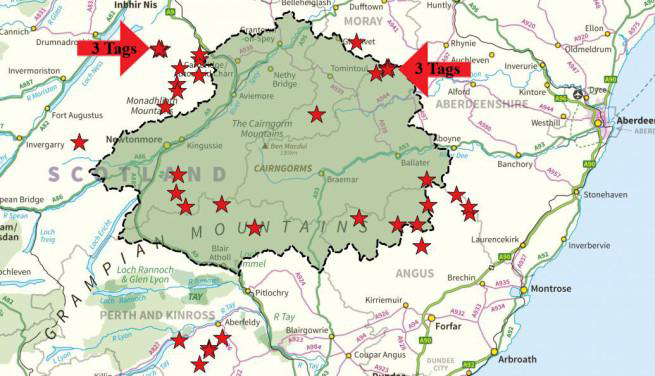
©Raptor Persecution UK
Ken Thomson
The long-awaited report to the Scottish Government (SG) on the management of grouse moors was published in December 2019.
Its remit was "to examine the environmental impact of grouse moor management practices such as muirburn, the use of medicated grit and mountain hare culls and advise on the option of licensing grouse shooting businesses. ..."It did not consider moor drainage or tracks, or disturbance by walkers. It found parts of the scientific and socio-economic evidence hotly contested or missing, but summarised as follows:
The review group studied several approaches, e.g. regulation, codes of practice, improved effectiveness of existing law, and financial incentives. It examined the pros and cons of licensing in some detail, including:
Pro: Licensing need not be onerous, allows a graduated scale of penalties, can be flexible, e.g. as to eligibility criteria, reporting requirements, and infringement penalties. It also constitutes a transparent system of control.
Against: current arrangements could be prosecuted (or strengthened) more effectively in general or in particular. Licensing would be unfair as between all operators, and in relation to e.g. agriculture and forestry (both subsidised). It might also endanger a valuable economic sector, and be challenged under human rights legislation.
In the end, the review group recommended unanimously that "a licensing scheme be introduced for the shooting of grouse if, within five years ... there is no marked improvement in the ecological sustainability of grouse moor management, as evidenced by the populations of breeding Golden Eagles, Hen Harriers and Peregrines on or within the vicinity of grouse moors being in favourable condition". It also proposed licensing for muirburn, increased legal regulation for the management of mountain hares, and a voluntary code of practice for the use of medicated grit, with licensing for the latter two activities if implementing those proposals proves ineffective. Licensing would fill a major evidence gap via a SNH register of grouse shooting activity.
 |
| Last known location of satellite-tagged golden eagles
©Raptor Persecution UK |
The report's recommendations are of course being argued vigorously, but ministers (e.g. the Environment Secretary, Roseanna Cunningham) have indicated that the recommended five-year delay may be reduced: Link and link
Nick Kempe has produced a critique of the report on his Parkswatch website
He points out that the report is a whitewash. It is well known that one of the main reasons for the delayed publication is that Werrity was forced to make concessions to the shooting representatives on the team to obtain a unanimous report.
The CNPA is criticised for failing to make use of its existing powers to regulate
grouse moor managers.
The most important criticism is reserved for SNH. They will be required to advise
ministers whether the proposed licensing system is needed in five years¡¦
time. Their track record to date in enforcing the EU Habitats Directive is appalling.
They have been content to report healthy populations of golden eagles, knowing
full well that black holes exist over moors intensively managed for driven grouse
shooting. A check on the Raptor
Persecution Society website shows the extent of the problem.
Two years ago the Environment Secretary was forced to give them a public dressing down over their mismanagement of deer numbers. They have been no better on grouse moors. They have only recently changed a "favourable" conservation status for mountain hares, despite knowing of Adam Watson's data showing severe declines. Can we trust them to stand up to the landowners? Probably not?
The good news is that Roseanna Cunningham, as quoted above, "is minded to act on the report before five years is up". Somebody, at least, is alert to the contradiction that our" guardians of the countryside" seem to be unable to stop killing anything that moves on a moor other than grouse. Predictably, groups representing shooting interests have come out with the party line of "zero tolerance" on the illegal killing of birds of prey. Link
We have heard many calls for zero tolerance in the past. Instead of calling for zero tolerance, maybe they should get their factors to speak with the people responsible? In industry, if somebody ignores the rules of the company, they get dismissed. It doesn't seem to work like that on estates managed for grouse shooting, unless those that make the rules don't actually want to see them obeyed.
To increase public awareness of the problem, the RSPB has started an on line heat map together with other information on wild bird crime.
The subject was featured on the BBC national news at 18.00 on the 17th February — gamekeepers were not portrayed favourably! Public awareness is undoubtedly increasing.
In the last issue, we noted that Alison Johnstone MSP had put forward a Bill to end the killing of mountain hares without a licence. This was part of a package to end hunting with dogs and provide improved protection to both brown and mountain hares and also red foxes. The consultation, now closed, was posted on the Parliamentary website.
NEMT responded to the consultation making the following points:-
We now hope that the proposed Bill progresses to the next stage of becoming a draft Member's Bill.
NEMT Front Page | Previous Page | Volume Index Page | Next Page | Journal Index Page
Please let the webmaster know if there are problems with viewing these pages or with the links they contain.